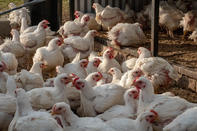It is more difficult to get rid of mites than lice on poultry, making prevention of this external parasite even more so important. Mites are smaller than lice, varying between a tenth of a millimetre to a millimetre in length.

It is therefore difficult to spot them unless they are moving on a contrasting coloured background. Where lice have six legs, adult mites and nymphs have eight legs and their larvae have six legs. Most species are round like a ball, with a small stalk-like object on which the mouthparts are situated.
Signs of infestation?
The blood-sucking habits of red mites and northern fowl mites will weaken birds and eventually produce severe anaemia, with birds having pale combs and wattles. The birds may also lose weight and become susceptible to other diseases.
The feathers of affected birds may become bedraggled, thin and patchy, which sometimes lead to feather plucking and reddened skin patches. Scaly leg mites burrow under the skin of the legs and feet, causing inflammation and roughness. Left untreated the birds might become lame and eventually die.
What do they look like?
The three main culprits affecting poultry are red mites (also known as chicken mites), northern fowl mites and scaly leg mites. Red mites are greyish white or brown in colour, but become bright red or blue after engorging itself with blood.
The parasite spends most of its day hiding in crevices as near as possible to their meal and then attack the birds at night. Northern fowl mites are grey or black coloured and spend their whole life-cycle on the bird, mostly around the vent.
Large infestations will cause blackening of feathers because of mite droppings and eggs. Unlike Northern fowl mites and red mites, scaly leg mites only affect the legs of birds.
By Glenneis Kriel